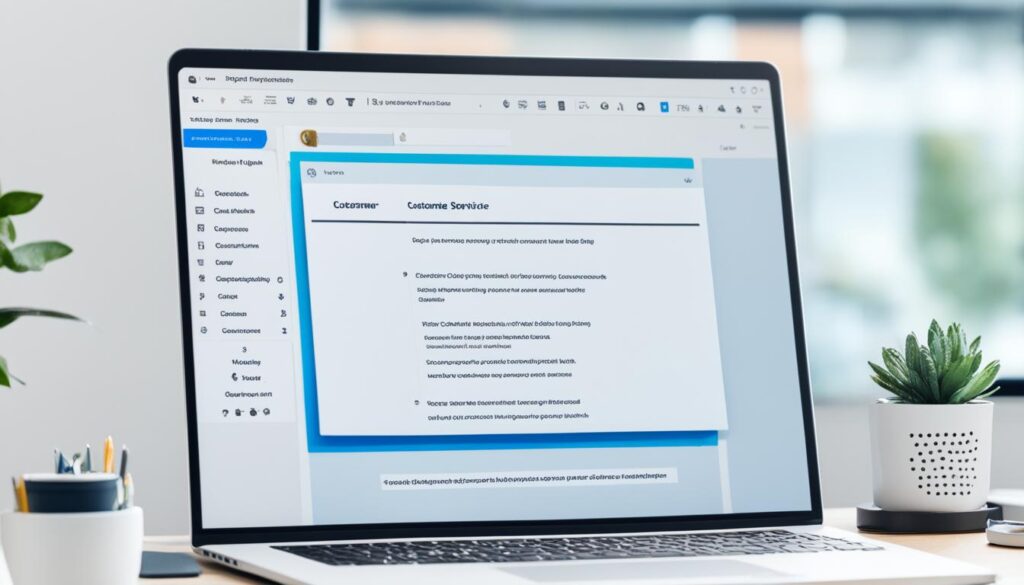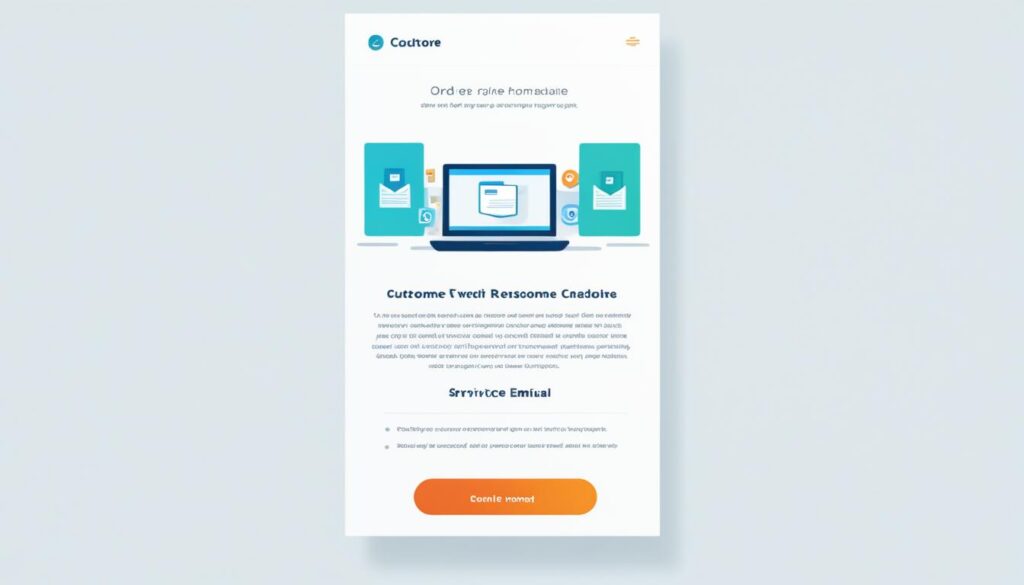Customer service email templates are a valuable tool for providing efficient and effective support to your customers. They help businesses save time, provide consistent responses, and ensure a high level of customer satisfaction. Using personalized templates can help build trust and maintain positive relationships with customers. In a survey, 62% of customers said they would switch to a different brand after one poor customer experience, highlighting the importance of providing impeccable customer service.
By following best practices for email communication and using customer service email templates, businesses can elevate their support and improve the customer experience.
The Importance of Effective Communication in Customer Service Emails
Effective communication is crucial in maintaining positive relationships with customers. When crafting customer service emails, it is important to personalize the email by addressing the customer by name and providing a custom greeting. Active listening is also important, as it shows that the company understands and acknowledges the customer’s concerns. Offering incentives, refunds, or discounts to customers who have had a negative experience can help resolve issues and demonstrate the company’s commitment to customer satisfaction. Following up with customers to ensure their issues have been resolved and asking for feedback can further enhance the customer experience. Customer service email templates provide a structure for addressing various customer service categories and situations, including complaints, questions, and requests.
Creating an engaging and effective customer service email requires more than just a generic response. Personalizing each email by using the customer’s name and addressing their specific concerns or questions helps build a connection and shows that you value their individuality.
Your customer service response should demonstrate empathy and understanding. Take the time to listen to your customers’ issues and concerns, and address them in a helpful and respectful manner. Use a polite and professional tone throughout the email to maintain a positive impression and build trust with your customers.
Here are a few customer service email examples that showcase effective communication:
Dear [Customer’s Name],
Thank you for reaching out to us with your concerns. We apologize for the inconvenience you have experienced and understand the frustration it may have caused. Rest assured, we are committed to resolving this issue for you as quickly as possible.
To make it right, we would like to offer you a [discount/refund/store credit] as a token of our apology. In addition, we have already taken steps to address the problem internally to prevent it from happening again in the future.
Please let us know if there is anything else we can do to assist you. We greatly value your feedback and appreciate your patience in this matter. We are dedicated to providing excellent customer service and will do everything we can to ensure your satisfaction.
Best regards,
Your Customer Service Team
By utilizing customer service email templates, you can ensure consistency in your responses while still providing a personalized touch. These templates serve as a guide, helping you address various customer service scenarios in a structured and efficient manner.
Below is an example of a customer service email template for addressing a customer complaint:
Dear [Customer’s Name],
Thank you for bringing this issue to our attention. We sincerely apologize for the inconvenience caused and understand your frustration. We want to assure you that your feedback is important to us, and we are committed to resolving this matter for you.
We have already initiated an investigation into the matter and are working diligently to resolve it. In the meantime, we would like to offer you [discount/refund/store credit] as a gesture of goodwill. We value your business and want to make sure you are satisfied with our products/services.
If there is anything else we can do to assist you, please don’t hesitate to let us know. We appreciate your patience and understanding.
Best regards,
Your Customer Service Team
By using customer service response templates, you can streamline your communication process and ensure that all customer inquiries and concerns are handled promptly and effectively. These templates provide a consistent framework for addressing different customer service situations and help you deliver timely and satisfactory responses.
Benefits of Using Customer Service Email Templates
| Benefits | Description |
|---|---|
| Time-saving | Customer service email templates allow you to respond quickly without sacrificing personalization. |
| Consistency | Templates ensure that your responses are consistent in tone, style, and messaging, maintaining a professional image. |
| Efficiency | Using templates helps you address customer inquiries and concerns more efficiently, maximizing productivity. |
| Accuracy | Templates provide a structured framework, reducing the chances of errors or omissions in your responses. |
| Customization | You can personalize each template with customer-specific information while maintaining a consistent structure. |
| Enhanced Customer Experience | By addressing customer inquiries promptly and effectively, you can improve customer satisfaction and loyalty. |

Best Practices for Writing Engaging Customer Service Emails
When it comes to writing customer service emails, following best practices can make a significant difference in the effectiveness of your communication. By employing these strategies, you can ensure that your emails are engaging, personalized, and highly effective in resolving customer issues. Here are some key tips to keep in mind:
- Address the customer by name: Using the customer’s name in the greeting helps create a personalized experience and shows that you value their individuality.
- Familiarize yourself with the customer’s history: Having knowledge of the customer’s conversation history, as well as any relevant information about their business or buyer persona, allows you to tailor your response to their specific needs.
- Understand the problem and offer specific solutions: Take the time to fully understand the customer’s problem or concern. Then, provide clear and specific steps or solutions to address their issue, demonstrating your commitment to resolving it.
- Anticipate extra questions or concerns: Put yourself in the customer’s shoes and think about the additional questions or concerns they may have. Proactively address these in your email, providing comprehensive information that helps put their mind at ease.
- Utilize customer service tools with built-in templates: Using customer service tools that offer pre-designed email templates can simplify the writing process and ensure that your emails are clear, consistent, and professional in appearance.
By following these best practices, you can enhance the overall customer experience and foster stronger relationships with your customers. The next section will focus on how to effectively respond to angry customer emails, equipping you with the necessary tools to handle challenging situations.

Quote:
Providing engaging and personalized customer service emails is essential for building strong relationships with your customers. By following best practices and using customer service tools, you can ensure your emails are effective and leave a positive impression.
How to Respond to Angry Customer Emails
When it comes to dealing with angry customer emails, prompt and effective responses are crucial to prevent the situation from escalating. By following a few key strategies, you can address customers’ concerns, resolve issues, and maintain their satisfaction.
1. Begin with a Genuine Apology
Start your response with a sincere apology that acknowledges the customer’s negative experience. This empathetic approach shows that you value their concerns and are committed to resolving the issue.
2. Provide an Explanation and Reassurance
Offer a clear explanation of what may have gone wrong and outline the steps you are taking to prevent similar issues in the future. This reassurance demonstrates your commitment to continual improvement and can help rebuild trust with the customer.
3. Offer Incentives or Solutions
If appropriate, consider providing incentives, refunds, or discounts as a gesture of goodwill. These offerings can help alleviate the inconvenience caused by the issue and show your commitment to customer satisfaction.
4. Encourage Further Communication
Invite the customer to reach out with any additional questions or concerns they may have. Assure them that you are available to address any further issues or clarify any information. This open line of communication helps foster trust and shows your dedication to their satisfaction.
5. Follow Up for Satisfaction
After addressing the customer’s concerns, follow up to ensure their satisfaction has been fully addressed. This demonstrates your commitment to resolving the issue and provides an opportunity to further strengthen the customer relationship.
By following these steps, you can effectively handle angry customer emails and turn a negative experience into a positive one. Remember, each interaction is an opportunity to enhance customer loyalty and showcase the exceptional customer service your business provides.
The Power of Customer Service Email Templates
Customer service email templates are a valuable asset for businesses looking to streamline their customer support processes. These templates provide a powerful tool for addressing a wide range of common customer service scenarios. By leveraging professional email templates, businesses can save time, ensure consistent messaging, and deliver prompt and satisfactory responses to their customers.
Here are some key benefits of using customer service email templates:
Saves time and increases efficiency
With pre-designed templates, you no longer need to draft each customer email from scratch. By having ready-made templates for various customer interactions, such as acknowledging receipt of an email or responding to a complaint, you can quickly tailor your message to fit the specific scenario. This not only saves time but also ensures a prompt response to your customers’ inquiries.
Ensures consistent messaging
Consistency in your customer service communication is crucial for building trust and maintaining a strong brand image. By using email templates, you can ensure that your messaging remains consistent across all customer interactions. Whether it’s addressing common FAQs or providing instructions for a specific process, templates guarantee that your customers receive a standardized and professional response every time.
Enhances customer satisfaction
By personalizing these templates with relevant customer information, you can create a more tailored and engaging email experience. Addressing customers by name and referring to their specific requests or concerns demonstrates that you value their individual needs. This personalization can lead to increased customer satisfaction and loyalty.
Facilitates effective problem-solving
Email templates provide a structured framework for addressing customer issues. They guide you in crafting well-thought-out responses that offer practical solutions or steps to resolve a problem. When customers receive clear and concise instructions or guidance, they are more likely to feel supported and trust in your ability to address their concerns.
Ensures professionalism and brand consistency
Consistent use of professional email templates helps maintain a polished and cohesive brand image. It ensures that your customer service responses align with your overall brand tone and values. Templates can include your branded logo and colors, further reinforcing your brand identity and professionalism.
By embracing the power of customer service email templates, businesses can elevate their customer support game, saving time, ensuring consistency, and ultimately delivering exceptional service that leads to increased customer satisfaction and loyalty.
Image:

Conclusion
Customer service email templates are an invaluable resource for businesses looking to provide efficient and effective support to their customers. By implementing best practices for email communication and utilizing personalized templates, you can greatly enhance the overall customer experience, foster trust, and nurture positive relationships. These templates can be utilized in various customer service scenarios, including acknowledging receipt of emails, following up on conversations, onboarding new customers, reminding customers about renewals, addressing complaints, apologizing for poor experiences, and notifying customers about product issues or service interruptions.
Customer service email templates offer numerous benefits. They save time by providing a structured framework for communication, ensuring consistent messaging across customer interactions. These templates also help streamline the response process, allowing your team to handle a large volume of inquiries without sacrificing quality. By personalizing the templates with relevant customer information, such as their name and previous conversation history, you can deliver a more tailored and attentive response.
Remember, the key to effective customer service email writing is to address the customer’s concerns promptly and sincerely. Show empathy, actively listen, and offer specific solutions to their problems. Consider using customer service email guides or professional email templates to streamline your communication and maintain a professional image. By leveraging the power of customer service email templates, you can elevate your support, exceed customer expectations, and leave a lasting positive impression.
FAQ
What are customer service email templates?
Customer service email templates are pre-designed email formats that businesses use to reply to customer inquiries, resolve complaints, and provide support. They offer a structure and framework for effective communication.
Why are customer service email templates important?
Customer service email templates are important because they save time, provide consistent responses, and ensure a high level of customer satisfaction. They help businesses streamline their support processes and maintain positive relationships with customers.
How can customer service email templates improve the customer experience?
Customer service email templates can improve the customer experience by providing personalized responses, addressing specific customer concerns, and offering relevant solutions. Templates ensure clear and professional communication, which enhances the overall customer experience.
In what situations can customer service email templates be used?
Customer service email templates can be used in various situations, including acknowledging receipt of emails, following up on conversations, onboarding new customers, reminding customers about renewals, responding to complaints, apologizing for poor experiences, and notifying customers about broken products or interrupted services.
How can I personalize customer service email templates?
To personalize customer service email templates, address the customer by name, provide a custom greeting, and refer to any relevant information or previous conversations. This shows the customer that you understand their specific situation and helps build trust.
What are the best practices for writing customer service emails?
The best practices for writing customer service emails include using the customer’s name, understanding their problem, offering specific solutions or steps to resolve the issue, anticipating extra questions or concerns, and using customer service tools with built-in templates.
How should I respond to angry customer emails?
When responding to angry customer emails, it is important to respond quickly, apologize for the negative experience, offer an explanation, and provide reassurance that steps are being taken to prevent the issue from happening again. If appropriate, offer incentives, refunds, or discounts to apologize for the inconvenience.
What is the power of customer service email templates?
The power of customer service email templates lies in their ability to save time, ensure consistency, and enhance the overall customer service experience. They provide a framework for communication and help businesses provide efficient and effective support to their customers.
How can customer service email templates benefit businesses?
Customer service email templates benefit businesses by saving time, improving efficiency, and ensuring consistent messaging. They also help build trust and maintain positive relationships with customers, leading to increased customer satisfaction and loyalty.
